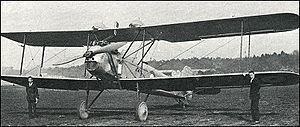Top speed 191 km/h Length 10 m First flight 1926 | Wingspan 14 m Retired 1933 | |
 | ||
The Vickers Vendace was a 1920s British trainer aircraft. It was originally designed as a floatplane trainer for the Royal Air Force.
Contents
Background
In October 1924, the British Air Ministry issued Specification 5A/24 for a floatplane trainer. To meet this requirement, Vickers designed a two-seat biplane, the Vickers Type 120 Vendace I. In August 1925, the Air Ministry placed an order for a single prototype, in addition to competing aircraft from Parnall and Blackburn, (the Parnall Perch and Blackburn Sprat).
Design and development
The Vendace I was a two-bay biplane with folding wooden wings and a steel tube fuselage, powered by a Rolls-Royce Falcon engine. Its undercarriage could be changed from floats to wheels in ten minutes, while its fuel supply was held in two streamlined tanks above the upper wing.
The first Vendace first flew at Brooklands by March 1926, and then underwent successful trials as a landplane, including operation from the aircraft carrier HMS Furious. In 1927, these were followed by testing in seaplane configuration at the Marine Aircraft Experimental Establishment, Felixstowe. Despite the successful trials, the RAF did not order production, although it did retain the aircraft for experimental purposes.
Vickers built a second aircraft, the Type 157 Vendace II, as a private venture, with an ADC Nimbus (an inline six-cylinder engine derived from the Siddeley Puma) that replaced the Falcon of the Vendace I. It first flew in November 1927, and was sold to the Aircraft Operating Company for survey operations in South America.
Development continued with the Type 155 Vendace III powered by a Hispano-Suiza 8F, and three were sold to Bolivia for use as trainers.
Operational history
In October 1928, the three Bolivian Vendaces entered service with the Escuela Militar de Aviación. They experienced engine problems, blamed on dusty conditions in the Bolivian summer, but remained in service until 1933.
Variants
Operators
Specifications (Vendace III)
Data from Vickers Aircraft since 1908
General characteristics
Performance
